|
|
Some Hot Topics in Electroceramics Research
LI Yong-Xiang
2014 Vol. 29 (1): 1–5
 Abstract
Abstract(
2280 )
 HTML
HTML(
13)
 PDF
PDF(297KB)(
1761
)
Information functional ceramics is a class of ceramic materials which have unique electrical, magnetic, acoustic, optical, thermal, mechanical, chemical and biological properties which convert one to another, generate coupling effects. The ceramic materials used primarily for their electrical properties are generally called electroceramics or functional ceramics. They have become of increasing importance in many key technologies including computers, wireless communication, automotive and industrial control systems. The developments in the various subclasses of electroceramics have paralleled the growth of new technologies. Examples include ferroelectrics-MLCC, FeRAM; ferrites-filters, resonators; solid electrolytes-energy storage and conversion; piezoelectrics-sonar, transducers, actuators; semiconducting oxides PTC & NTC-environmental monitoring. The trend of electroceramics are thin films, low-dimensional materials, multiphase, multi-functional, textured, single crystal and high uniformity, low-cost, LTCC, environmental friendly. The new components and devices are to be miniaturized, low power comsuption, microwave, high-power, intelligent and high reliability under extreme conditions.
Recently, as the increasing awareness of environmental protection, the rapid growth in demand for energy and its impact on air-pollution have become increasingly prominent. Therefore, the studies on lead-free piezoceramics, high-performance dielectric for energy storage capacitors, as well as giant electrocaloric effect become three hot topics on the research of functional ceramics.
1 KNN based lead-free piezoceramics with d33 > 400 pC/N
There are three main lead-free piezoelectric materials, e.g. BaTiO3, Na0.5Bi0.5TiO3 and K0.5Na0.5NbO3, among which the KNN is the most promising candidate for substitute of PZT-based ceramics[1-2].
It is reported that there is a phase boundary between two orthorhombic phases near the composition K/Na = 47/53 which resulting in superior piezoelectric properties[3]. The pure KNN undergoes a series of phase transitions at 690 K(TC-T), 480 K(TT-O) and 158 K(TO-R). Ion substitution can change the phase transition temperature thus may improve the ferroelectric and piezoelectric properties. The A-site is usually substituted with Li+, Ag+ ions, and Ta5+, Sb5+ ions are in the B-site. While in unbalanced situation, the A-site is doped with Ca2+, Sr2+, Ba2+, even co-doped with(Bi0.5Li0.5)2+, (Bi0.5Na0.5)2+, (Bi0.5K0.5)2+, and Ti4+, Zr4+ in the B-site.
Li+ is the only dopant ion that can increase the TC of KNN. It was studied that the valence mismatch could cause the TC to rapidly decrease[4]. T-O and O-R phase transitions are strongly dominated by B-site ions. Both TT-O and TO?R decrease by substituting of Ti4+ substation in B-site and almost independent of A-site ions[5]. Zr4+ ion also decreases TT-O but increases TO-R, 8% Zr4+ addition will stabilize the rhombohedral phase to room temperature. Sb5+ can also increase the TO-R, and 9% content Sb5+ substitution increases TO?R to room temperature. Ta5+ substitution decreases the TC-T and TT-O at the same time. It is noted that 40% Ta5+ addition decreases the TT-O to room temperature[4,6]. It could concluded that the TO-R may not merely affected by the chemical pressure introduced by different B-site ionic radii but also the chemical bond strength. In short, through the optimization of MPB, in 0.90(Na0.5K0.5)NbO3-xBaZrO3-(0.10-x)(Bi0.5Li0.5)TiO3 system, when x = 0.7-0.8, d33 = 230-265 pC / N, kp = 40.6%-41.9% could be obtained. For the ceramic with a composition of 0.92(Na0.5K0.5)NbO3-0.06BaZrO3- 0.02(Bi0.5K0.5)TiO3-0.25wt% MnO2, d33 = 420 pC/N, kp = 56%, Tc = 243℃ were achieved[7-9]. These piezoelectric properties at room temperature are very close to that of PZT-4 ceramics. However, the temperature stability and long-term reliability remains questionable and to be tested further. The recent study on the "vertical MPB" has become an important issue[10].
The phase transitions (MPB, PPT) of KNN-based ceramics with different ions substitution still need to be explored. KNN-based ceramics seems to be the most promising substitution of PZT for devices applications.
2 High-performance ceramic dielectrics for energy storage
Dielectric capacitors posess advantages of high energy density, fast charge and discharge, anti-aging cycle under extreme environmental conditions. It is highly demanded for electric vehicles, power electronics, pulse power systems, high energy density weapons, renewable energy and smart grid systems[11] .
EEStor Inc. of US filed a number of patents on dielctric ultracapacitors, e.g. “Electrical-energy-storage unit (EESU) utilizing ceramic and integrated-circuit technologies for replacement of electrochemical batteries” [12]. EEStor reports a large relative permittivity (19818) at an unusually high electric field strength of 350 MV/m, giving 104 J/cm3 in the dielectric. The capacitor can store more energy than lithium-ion batteries used in portable devices for cheaper than the low-cost lead-acid batteries used in gasoline powered cars. Its claims, if true, would radically change the electric car industry. However, the technology still has not publicly demonstrated.
Zhang, et al[13] reported dielectric polymers with high dipole density have the potential to achieve a very high energy density (> 17 J/cm3, >575 MV/m) with fast discharge speed and low loss, by using defect modified poly(vinylidene fluoride) polymers. Recently, Liu, et al[14] reported high-performance colossal permittivity material of (Nb/In) co-doped rutile TiO2 ceramics, due to the formation of electron-pinned defect-dipoles (defect-dipole clusters). The new high-performance dielectric materials, exhibiting temperature- and frequency-stable, with a giant dielectric constant ( > 104) and a small dielectric loss (< 0.05) .
Currently, the research work on the glass coated grains, glass with nano-polar region, as et al. well as BaTiO3 coated with Al(OH)x ionic layer, which may form electrochemical pseudo-capacitance. Randall, et al[15] invented a new type of capacitor that combines electrochemical pseudo-capacitor with ceramic capacitor energy storage. The ionically conducting dielectric materials may have heterogeneously distributed conductivity that may generate barrier layer effects. The Ionic-Based-Barrier-Layer (IBBL) effect may generate an effective barrier layer capacitance. Meanwhile, a dielectric layer is also introduced the electric double layer capacitor to improve its working voltage. New concepts and mechanism of dielectric capacitors will greatly stimulate the studies and applications of capacitor energy storage technologies.
3 Giant electrocaloric effect
The electrocaloric effect (ECE) is a change in temperature (ΔT) in a polarable material by virtue of the change in entropy (ΔS) upon the application of or withdrawing of an electric field under adiabatic conditions. The ECE occurs in both ferroelectric and paraelectric phases, and the effect is larger in the paraelectric phase just above the F-P transition.
In 2006, Mischenko, et al[16] reported that “giant” ECEs were found in ferroelectric ceramic Pb(Zr0.95Ti0.05)O3 thin films by Sol-Gel preparation at temperatures near and above the F-P transition. The film with a thickness of 350 nm, working at 48 MV/m, showed an adiabatic temperature change (ΔT) of 12℃, the entropy change ΔS = 8 J/(kg?K). Shortly thereafter, Qiming Zhang, et al[17] reported that in the ferroelectric copolymer (P(VDF-TrFE), 68/32 mol%) large ferroelectric-paraelectric phase transition heat of 2.1×104 J/kg, the entropy change ΔS = 56.0 J/(kg?K) were ontained, which draw geat attention to use the solid-state electrocaloric effects to developed new model of cooling system.
Lu, et al[18] revealed that giant ECEs can be obtained in the high energy electron irradiated poly (vinylidene fluoride-trifluoroethylene) relaxor copolymer and in the La-doped Pb(ZrTi)O3 relaxor ceramic thin films, which are much larger than that from the normal ferroelectric counterparts. The adiabatic temperature change of 40 K and isothermal entropy change of 50 J/(kg?K) were achieved . Recently, Huiqing Fan, et al.[19] found that a giant electrocaloric effect (ΔT = 45.3 K and ΔS = 46.9 J/(kg?K) at 598 kV/cm) was obtained in nanoscale antiferroelectric and ferroelectric phases coexisting in a relaxor Pb0.8Ba0.2ZrO3 thin films at room temperature.
The above exited results of these studies indicate a new refrigeration technology to achieve the possibility of change, the use of solid-state electronic cards to replace the traditional principle of Carnot refrigeration compressor refrigeration ultra-small size, energy efficient, environmentally friendly and without refrigerants. A new generation of refrigerators, air conditioners become a new functional ceramics research focus .
The ECE may provide an efficient means to realize solid-state cooling technology. New refrigeration based on the ECE approach is more environmentally friendly and hence may also provide an alternative to the existing vapor-compression approach.
|
|
|
Large Electrocaloric Effect in Ferroelectric Materials
LU Sheng-Guo, TANG Xin-Gui, WU Shang-Hua, ZHANG Qi-Ming
2014 Vol. 29 (1): 6–12
 Abstract
Abstract(
2483 )
 HTML
HTML(
17)
 PDF
PDF(373KB)(
2244
)
The electrocaloric effect (ECE) in polar materials shows great potential in realizing high efficient solid-state cooling devices with a smaller size and high efficiency. The thermodynamic theory was introduced in order to achieve a large ECE in ferroelectrics. The previous experimental researches were reviewed and discussed. A novel method to directly measure the ECE entropy change and temperature change was developed. Results indicated that the relaxor ferroelectric polymers and first-order phase transition polymers demonstrated larger ECE. Recently published larger electrocaloric effect in BaTiO3 crystal and multilayer ceramic capacitors, and the prototype ferroelectric cooling devices reveal attractive application prospects in the near future.
|
|
|
(K, Na)NbO3-based Lead-free Piezoceramics: Status, Prospects and Challenges
WANG Ke, SHEN Zong-Yang, ZHANG Bo-Ping, LI Jing-Feng
2014 Vol. 29 (1): 13–22
 Abstract
Abstract(
1866 )
 HTML
HTML(
12)
 PDF
PDF(504KB)(
2098
)
The past decade has witnessed the rapid development of (K,Na)NbO3 (KNN)-based lead-free piezoceramics. The present article reviews the current status of this system, with special emphasis on crystalline structure, piezoelectric performance and processing technologies based on the authors’ research work. In addition, the prospects and challenges are also analyzed according to the authors’ knowledge.
|
|
|
Preparation of 0.84(K0.48Na0.52)NbO3-0.16K0.56Li0.38NbO2.97 Lead-free Piezoelectric Ceramics by Multi-layer Process
ZHANG Zhi-Qiang, LIU Zhi-Fu, LI Yong-Xiang
2014 Vol. 29 (1): 23–27
 Abstract
Abstract(
1052 )
 HTML
HTML(
5)
 PDF
PDF(683KB)(
1362
)
0.84(K0.48Na0.52)NbO2.97-0.16K0.56Li0.38NbO2.97 lead-free piezoelectric ceramics were prepared by multi-layer process. Effects of sintering temperature and holding time on the density, crystal structure, microstructure, dielectric, and piezoelectric properties of the ceramics were investigated. All the ceramics exhibit a coexistence of perovskite and tungsten bronze structure. The ceramics sintered at 1050℃ for 8 min exhibit the largest relative density up to 95%, and the optimized dielectric constant, dielectric loss, and piezoelectric constant of εr=618, tanδ=0.027, and d33=112 pC/N, respectively. Moreover, the volatilization of K and Na is inhibited due to the lower sintering temperature and much shorter holding time of the multi-layer process.
|
|
|
Effect of Sn Content on the Phase Structure and Electrical Properties of PbSnO3-Pb(Mg1/3Nb2/3)O3-PbTiO3 Ternary Ceramics
WANG Da-Wei, ZHAO Quan-Liang, CAO Mao-Sheng, CUI Yan, ZHANG Shu-Jun
2014 Vol. 29 (1): 28–32
 Abstract
Abstract(
819 )
 HTML
HTML(
5)
 PDF
PDF(416KB)(
1164
)
PbSnO3-Pb(Mg1/3Nb2/3)O3-PbTiO3 (PSn-PMN-PT) ternary ceramics were successfully prepared by two-step columbite precursor method. The effects of Sn content on the phase structure and electrical properties of PSn-PMN-PT were investigated. X-ray powder diffraction (XRD) results indicated that all studied PSn-PMN-PT compositions located around the morphotropic phase boundary (MPB), with rhombohedral and tetragonal phases coexisted. With the decrease of Sn content, no change was observed in the XRD patterns of PSn-PMN-PT, while pyrochlore phase presented with excess Sn. The piezoelectric, dielectric and ferroelectric properties of PSn-PMN-PT were found to be improved with deficient Sn and deteriorate with increasing Sn content. In particular, the optimum piezoelectric and ferroelectric properties were achieved for PSn-PMN-PT ceramics with 0.2mol% deficient Sn, i.e. d33=~530 pC/N, kp=~56.4%, Qm=~570, εr=~3070, tanδ=~0.3%, Pr=~28.9 μC/cm2 and EC=~8 kV/cm.
|
|
|
Structure and Properties of (Ba0.85Ca0.15)(Ti0.9Zr0.1-xSnx)O3 Lead-free Ceramics with High Piezoelectric Constant
JIANG Xiang-Ping, LI Lu, CHEN Chao, TANG Jie, ZHENG Kai-Ping, LI Xiao-Hong
2014 Vol. 29 (1): 33–37
 Abstract
Abstract(
1129 )
 HTML
HTML(
3)
 PDF
PDF(463KB)(
1249
)
Lead-free piezoelectric ceramics (Ba0.85Ca0.15)(Ti0.9Zr0.1-xSnx)O3(CBTZS-x) were prepared by the traditional solid state reaction. Phase structure, dielectric and piezoelectric properties for CBTZS-x samples with different Sn contents were investigated. It is found that all samples have a pure perovskite phase structure. With Sn content increase, the phase structure of CBTZS-x changes from coexistence of rhombohedral and tetragonal phase to tetragonal structure near room temperature. The phase change temperature of rhombohedral to tetragonal (TR-T) and Curie temperature (TC) shift towards lower temperature. When x=0.04, the TR-T is more close to room temperature, which shows excellent piezoelectric properties. The remnant polarization Pr and coercive field Ec are reduced, while dielectric constant εr is improved by the modification of Sn. The CBTZS-x ceramic with x=0.04 exhibits the optimal properties: d33=665 pC/N, kp=55.6%, εr=4520, Pr=12.5 μC/cm2 and Ec=1.6 kV/cm, which indicates that the CBTZS ceramic has a good application prospect.
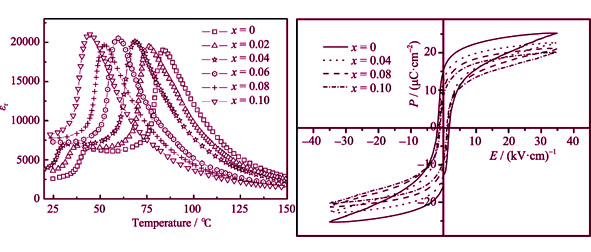
|
|
|
First-principles Study of Intergrowth Bismuth Layer-structured Ferroelectric Bi7Ti4NbO21
LIU Feng, LU Yi-Qing, LI Yong-Xiang
2014 Vol. 29 (1): 38–42
 Abstract
Abstract(
757 )
 HTML
HTML(
2)
 PDF
PDF(376KB)(
1268
)
Intergrowth bismuth layer-structured ferroelectric Bi7Ti4NbO21 material (iBTN) is a natural super lattice structure with excellent properties. Ferroelectric iBTN and parent compounds Bi3TiNbO9 (BTN) and Bi4Ti3O12 (BiT) were studied with first-principles method based on density functional theory (DFT). The band structures and the density of states of different compounds were calculated based on their optimized structures. The enthalpy of formation and band gaps of iBTN, BTN and BiT are -56.21, -30.72, -43.32 eV and 0.796, 2.535, 2.436 eV, respectively. The analysis shows that the intergrowth structure iBTN stays at a thermodynamic metastable state in relative to BTN and BiT. The electronic conductivity of iBTN is mainly depended on the perovskite layers, and the narrowed band gap is attributed to the down shift of the bottom of the conduction band. Detailed partial density of states of iBTN shows that different perovskite layers have different effects on the conduction band which suggests that the electrons choose their transportation channels in this material. This study can improve the understanding of the intergrowth mechanism and the influence between the structure and the electronic properties of iBTN.
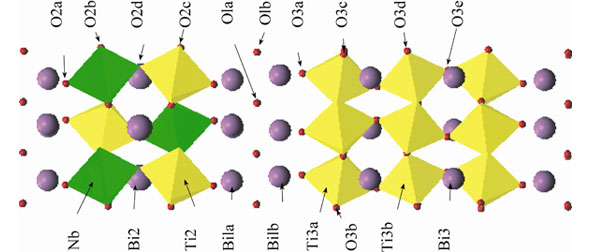
|
|
|
Preparation and Characterization on Piezo-/Ferro-electric Properties of (1-x)(KNN+LT)+xBI Ceramics
CHU Tao, AI Liao-Dong, LONG Xi-Fa
2014 Vol. 29 (1): 43–46
 Abstract
Abstract(
826 )
 HTML
HTML(
2)
 PDF
PDF(432KB)(
1279
)
Lead free ferroelectric ceramics, (1-x)(0.97Na0.5K0.5NbO3+0.03LiTaO3)+xBiInO3[(1-x)(KNN+LT)+xBI] ternary solid solution system were prepared by conventional solid state reaction method. The polycrystal structure, dielectric and piezo-/ferro-electric properties were systematically characterized. The results show that the (1- x)(KNN+LT)+ xBI ceramics present pure perovskite structure in which the orthorhombic and tetragonal phases coexist at room temperature. With increasing of BI content, the tetragonal phase and the lattice parameter increase gradually and the Curie temperature Tc decreases, while the phase transition temperature To-t from orthorhombic to tetragonal phase increases. With more BI addition, the electric properties decrease with the appearance of oxygen vacancy due to Bi loss at high temperature. The optimal properties are achieved in the (1-x)(KNN+LT)+ xBI ceramics (x=0.0015) with the Curie temperature Tc= 400℃, phase transition temperature To-t =126℃, piezoelectric constant d33 =160 pC/N, remnant polarization Pr=19.26 μC/cm2 and coercive field Ec =7.75 kV/cm.
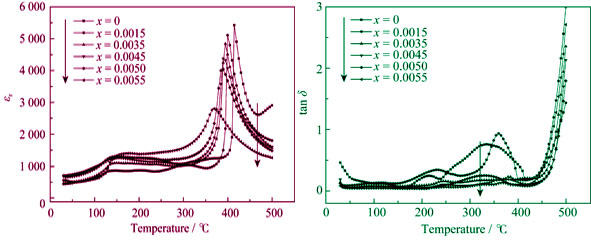
|
|
|
Growth and Characterization of a New Lead Lutetium Niobate with Lead Titanate Ferroelectric Crystal
LIU Ying, LONG Xi-Fa
2014 Vol. 29 (1): 47–51
 Abstract
Abstract(
709 )
 HTML
HTML(
2)
 PDF
PDF(466KB)(
1302
)
A series of new lead lutetium niobate with lead titanate (1-x)Pb(Lu1/2Nb1/2)O3-xPbTiO3 (PLN-xPT) ferroelectric crystals were grown successfully by the top-seed solution growth technique. Structural analysis and electrical properties measurement showed that the crystals have high Curie temperatures and each composition had different performances. The temperature dependences of permittivity showed typical relaxor behavior in the rhombohedral phase region. Based on the measurement result, a solid state phase diagram in the low temperature range was established, which revealed a morphotropic phase boundary (MPB) in the composition of x = 0.49 to 0.51. Electric domains on (001) surface were observed by the polarizing microscope, in agreement with the X-ray diffraction data. Those compositions within MPB exhibited good piezoelectric properties, such as high coercive field Ec (>10 kV/cm) and high rhombohedral-tetragonal phase transition temperature TRT (> 200℃). For PLN-0.49PT, it had a high Curie temperature Tc = 360℃ and a piezoelectric coefficient of d33 > 1600 pC/N. High Curie temperature and excellent piezoelectric property make this material a promising candidate which can operate in a wider temperature range.
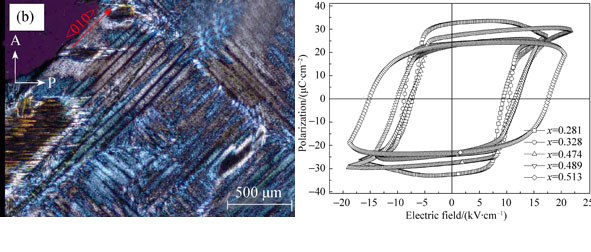
|
|
|
Preparation and Dielectric Properties of (BaxSr1-x)TiO3/Mg2TiO4 Composite Ceramics with A Functionally Graded Structure
LI Jun, WANG Xu-Sheng, CHAI Xiao Na, LIU Peng
2014 Vol. 29 (1): 52–56
 Abstract
Abstract(
833 )
 HTML
HTML(
2)
 PDF
PDF(643KB)(
1232
)
(BaxSr1-x)TiO3/Mg2TiO4 composite ceramics with a constituent graded structure were prepared by a solid-state reaction method. Their microstructure and dielectric properties were analyzed by X-Ray diffraction (XRD), Scanning Electron Microscope (SEM), Energy Dispersive Spectroscope (EDS) and dielectric property measurements. The results show that the samples sintered at 1375℃ for 3 h are a composite phase of perovskite and spinel structure with a Ba/Sr ratio composition gradient. Compared with the composite samples with a fixed Ba/Sr ratio, the graded samples possess higher tunability and better temperature stability of dielectric properties. At room temperature (20℃), the tunability of a typical sample is 21.9% under an external DC field of 2 kV/mm, and it maintains a high value of 9.3% at high temperature of 60℃. The improvement of temperature stability is due to the difference in Curie temperature for different layers in gradient (Ba,Sr)TiO3. Meanwhile, the introduction of the composition gradient in this material helps us to obtain a wide temperature application range for the related device.
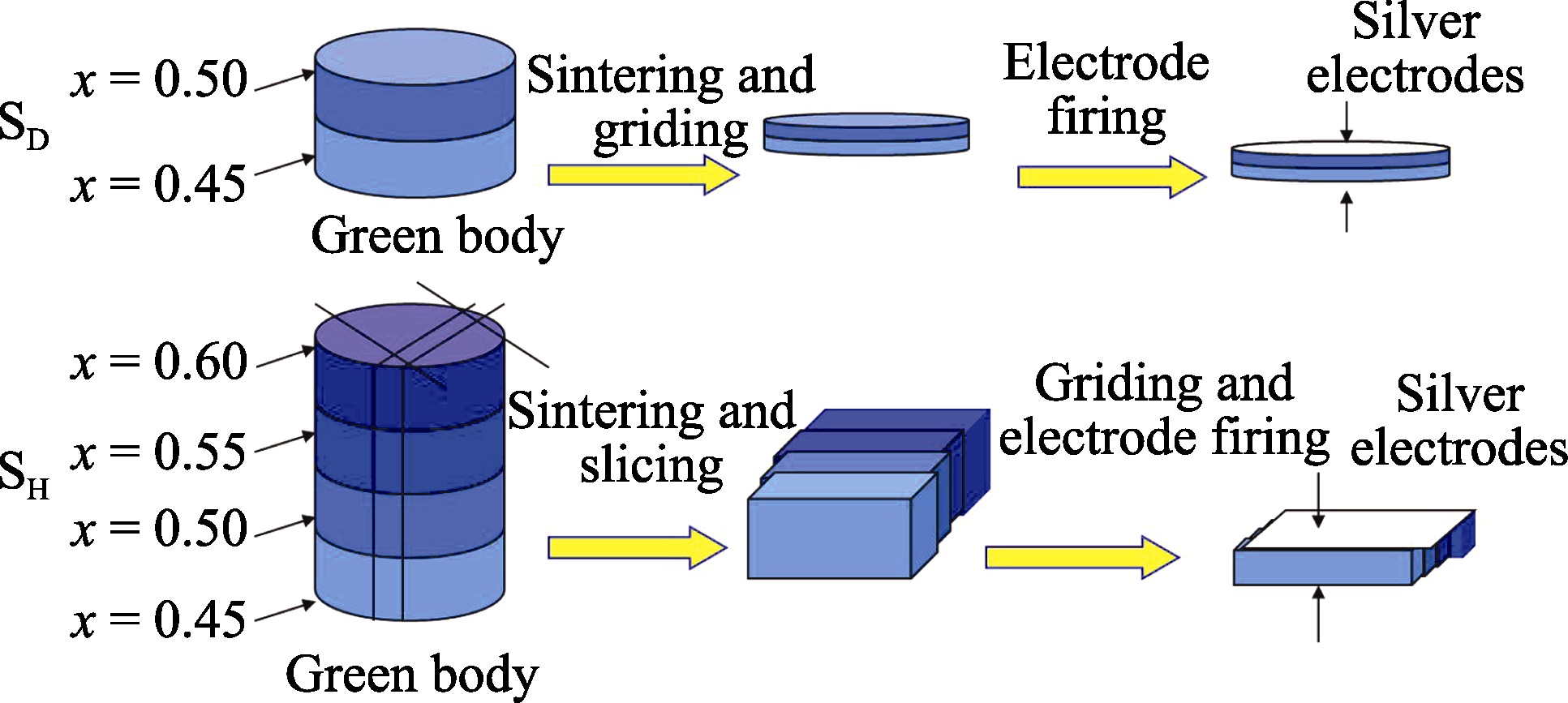
|
|
|
Structure and Dielectric Relaxation Behavior of Rutile-type FeTiNbO6 Ceramics
WANG Sai, HOU Yu-Dong, ZHENG Mu-Peng, Duan Cheng-Hui, ZHU Man-Kang, YAN Hui
2014 Vol. 29 (1): 57–61
 Abstract
Abstract(
731 )
 HTML
HTML(
2)
 PDF
PDF(439KB)(
1237
)
The dense FeTiNbO6 ceramics were prepared through a solid-state method. The phase structure and electrical behavior were investigated in detail. The results reveal that FeTiNbO6 are tetragonal rutile structure, and the refined lattice parameters are a=b=0.4652 nm and c=0.3013 nm. Compared with pure TiO2 rutile, the larger crystalline distortion in FeTiNbO6 ceramics induces emergence of ferroelectric behaviour. Due to the equivalent occupations of heterovalent ions in the octahedral center, the FeTiNbO6 ceramics show the dielectric relaxation phenomena of diffuse phase transition and frequency dispersion. The dc conductivity of the sample comes mainly from the ionization and migration of oxygen vacancies, and the transition point is close to the phase transition region. The results indicate that FeTiNbO6 ceramics are promising candidates for lead-free ferroelectric relaxor.
|
|
|
Giant Dielectric-Permittivity Property of NaCu3Ti3NbO12 and NaCu3Ti3SbO12 Ceramics and Low Dielectric Loss in NaCu3Ti3SbO12 Ceramics
HAO Wen-Tao, XU Pan-Pan, ZHANG Jia-Liang, CAO En-Si, PENG Hua
2014 Vol. 29 (1): 62–66
 Abstract
Abstract(
5177 )
 HTML
HTML(
2)
 PDF
PDF(393KB)(
1216
)
NaCu3Ti3NbO12 and NaCu3Ti3SbO12 ceramics were prepared by the conventional solid state reaction method, and their dielectric properties and crystalline structure were investigated. It was found that they were quite similar with the CaCu3Ti4O12 ceramics, showing giant dielectric-permittivity properties with ε' larger than 7×103. Within the measuring frequency range of 40 Hz-100 MHz, a single dielectric relaxation with the characteristic frequency around 1 MHz was detected at room temperature or below whereas an additional one in low frequency region is also observed at high temperatures. Furthermore, the existence of CuO secondary phase was confirmed by X-ray diffraction. In general, the results can be explained by the similar mechanism of internal barrier layer capacitance effect which was formerly proposed for CaCu3Ti4O12 ceramics. Here, it is worthy pointing out that the tanδ of NaCu3Ti3SbO12 ceramics is lower than 0.05 in a large frequency range from 40 Hz to 7 kHz, and the tanδ at 1 kHz is lower than 0.05 in a large temperature range of -50℃ to 80℃ at 1 kHz, which is a desirable characteristic for practical applications.
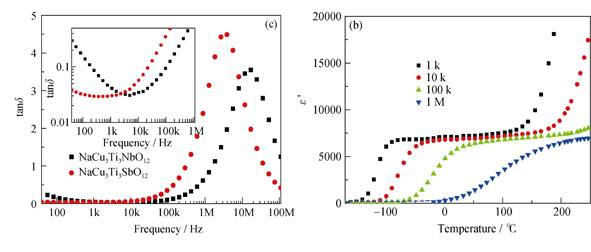
|
|
|
Dielectric Property of High Density CaCu3Ti4O12 Ceramics
HAO Wen-Tao, ZHANG Jia-Liang, XU Pan-Pan, CAO En-Si, PENG Hua
2014 Vol. 29 (1): 67–70
 Abstract
Abstract(
770 )
 HTML
HTML(
3)
 PDF
PDF(572KB)(
1191
)
High density CaCu3Ti4O12 ceramics was prepared by the hot-press sintering technique, and their microstructure, crystalline structure and dielectric property were investigated. The hot-pressed ceramics exhibit the microstructure of bimodal grain distribution with a high theoretical relative density of 98.3%. X-ray diffraction analysis shows that there is Cu2O minor phase in the hot-pressed ceramics whereas only CuO secondary phase exists after a further thermal treatment in ambience. Both the hot-pressed ceramics and its further thermally treated one exhibit two dielectric relaxations at room temperature, whereas the conventionally sintered ceramics have only one dielectric relaxation. Moreover, the hot-pressed CCTO ceramics have an extremely large low-frequency permittivity of 2×105, which further increases to nearly 1×106 through the ambient thermal treatment. The relation between microstructure and dielectric property is also discussed.
|
|
|
Preparation and Dielectric Properties of the Three-phase Composites of Graphite Oxide/Barium Titanate/Epoxy Resin
KOU Si-Wang, YU Shu-Hui, SUN Rong, YANG Hai-Peng
2014 Vol. 29 (1): 71–76
 Abstract
Abstract(
919 )
 HTML
HTML(
3)
 PDF
PDF(627KB)(
1329
)
Polymer-based dielectric composites have important applications in the fields of power engineering, microelectronics and high-density packaging. In this study, graphite oxide was prepared through oxidizing nature graphite ?akes with concentrated sulfuric acid and potassium permanganate. And graphite oxide/barium titanate/epoxy resin (GO/BT/ER) three-phase composites were prepared. Dielectric performance of the composites with varied GO loading amounts was investigated. The experimental results showed that the GO/BT/ER composites with low GO loading amount exhibited higher dielectric constant than that of BT/ER and the dielectric loss remained low. The dielectric constant of 3wt%GO/BT/ER composite was 42.6 and the dielectric loss was 0.043 (20℃, 1 kHz), while the dielectric constant of the BT/ER composites was 17.7. Therefore, the GO/BT/ER composites are promising candidates for the embedded dielectrics. Furthermore, the mechanism of graphite oxide on the dielectric properties of the composites also explored.
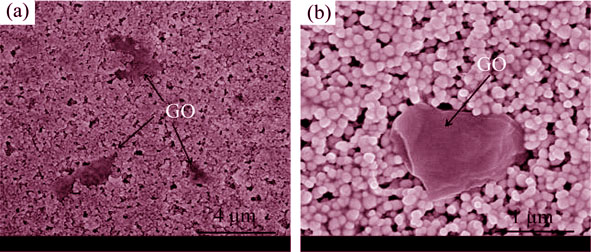
|
|
|
Giant Magnetodielectric Effect and Magnetic Properties of Ho0.5Pr0.5FeO3 Ceramics
XIE Hui, YUAN Shu-Juan, KANG Bao-Juan, LU Bo, CAO Shi-Xun, ZHANG Jin-Cang
2014 Vol. 29 (1): 77–80
 Abstract
Abstract(
880 )
 HTML
HTML(
2)
 PDF
PDF(371KB)(
1312
)
Polycrystalline sample Ho0.5Pr0.5FeO3 was prepared by a solid state reaction method. The magnetic properties and magnetodielectric effect of the sample were investigated. The results show that the Ho3+ antiferromagnetoly orders at T=4.5 K and the Fe3+ spin reorientation transition occurs at 59-80 K. The sample exhibits a colossal dielectric constant value of ~103 around 270 K, which is correlated with a resistance transition at 270 K. The decrease of the resistance and the dielectric loss lead to the increase of the dielectric constant. Most importantly, a magnetic field of 1.6×106 A/m can induce a giant magnetodielectric response of 5500% under?kHz at room temperature. The giant magnetodielectric effect might come from the magnetorisistance effect.
|
|
|
Influence of CaSi Oxide on Microstructure and Magnetic Properties of Sr1-xLaxFe11.6-xCoxO19 Hexaferrite
CHEN Zhong-Yan, FENG Ze-Kun, ZHAN Zhen-Hua, WU Jie
2014 Vol. 29 (1): 81–84
 Abstract
Abstract(
701 )
 HTML
HTML(
2)
 PDF
PDF(772KB)(
1196
)
Based on the standard ceramic preparation process, the effects of CaSi oxide on the microstructure and magnetic properties of Sr1-xLaxFe11.6-xCoxO19 were studied. The microstructural, morphology and magnetic properties of the samples were characterized by XRD, SEM and VSM. The SEM results show that the morphology of calcined samples are effective controled by CaSi oxide. So the ideal microstructure and enhanced Mr/Ms can be obtained by optimizing the amount of CaSi oxide. With x=0.2, 0.15wt% CaCO3 and 0.2wt% SiO2 were added to the Sr1-xLaxFe11.6-x CoxO19 and the measured σs and HcJ were enhanced by 4.76% and 6.2%, respectively, when compared with non-doped sample. Meanwhile, the Mr/Ms was improved as well in the above mentioned doping range.
|
|
|
Preparation and Electrical Properties of (LaMn0.8Al0.2O3)1-x(Al2O3)x(0.05≤x≤0.2) NTC Ceramics
ZHAO Li-Jun, ZHANG Hui-Min, CHANG Ai-Min, ZHAO Peng-Jun, ZHANG Bo, ZHANG Bing-Yin
2014 Vol. 29 (1): 85–90
 Abstract
Abstract(
1023 )
 HTML
HTML(
3)
 PDF
PDF(490KB)(
1172
)
(LaMn0.8Al0.2O3)1-x(Al2O3)x (0.05≤x≤0.2) negative temperature coefficient (NTC) ceramics were synthesized through a standard solid-state method. Thermogravimetry-differential scanning calorimetry (TG-DSC), X-ray diffraction (XRD), scanning electron microscope (SEM), energy dispersive spectroscope (EDS), resistance-temperature measurement and aging test were carried out to characterize the optimal calcined temperature, phase structure, morphology, elements concentration, R-T properties and electrical stability, respectively. The results show that the electrical resistivity of the ceramic samples increases remarkably as Al2O3 content increasing, while the constant B value has just little change. Specially, the ceramics exhibit superior properties of low B value (2816.44 K) and high resistivity (11893.89 Ω?cm) when x=0.15. In addition, the resistance variation (ΔR/R) of samples is less than 0.94% after aging at 125℃ for 500 h.
|
|
|
Effect of Y Substitution on Electrical Properties of Yn(Ba0.8Bi0.2)1–nFe0.9Sn0.1O3 Negative Temperature Coefficient Thermistor Ceramics
YUAN Chang-Lai, LUO Ying, ZHOU Xiu-Juan, YANG Yun, CHEN Guo-Hua, LIU Xin-Yu
2014 Vol. 29 (1): 91–97
 Abstract
Abstract(
747 )
 HTML
HTML(
3)
 PDF
PDF(771KB)(
1185
)
Negative temperature coefficient thermistor ceramics based on Yn(Ba0.8Bi0.2)1–nFe0.9Sn0.1O3 were fabricated by conventional solid-state reaction techniques. Phases, microstructures, resistance-temperature curves and impedance characteristics of thermistor ceramics were characterized by X-ray diffraction, scanning electron microscope, resistance-temperature tester and ac impedance analyzer, respectively. Yn(Ba0.8Bi0.2)1–nFe0.9Sn0.1O3 thermistor ceramics with pseudo-cubic perovskite structure show average grain size of ~1.0 μm and the decreasing lattice parameter a with increase of Y content. Room-temperature resistivity, thermistor constant and activation energy of thermistor ceramics are in the range of 2.17–9.17 MΩ·cm, 6757–7171 K and 0.583–0.618 eV, respectively. When n = 0.02 and 0.04, the ceramic resistance is mainly attributed to the contribution of grain boundaries, grains and grain shells. Among them, the resistance value of grain is the highest one. However, for the ceramics with n = 0.06 and 0.08, the total resistance of thermistor ceramics is ascribed to the contribution of grain boundaries, domain walls and domains, and the domain regions show the larger resistance value than that of the other two elements. In the limited measured temperature range, all of grain boundaries, grain shells, grains, domain walls and domains show negative temperature coefficient thermistor behavior.
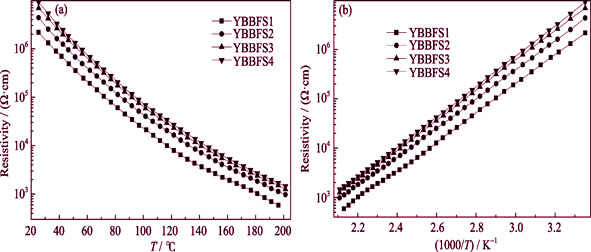
|
|
|
Preparation and Corona Resistant of Polyimide/TiO2 Nanocomposite Films
KONG Yu-Nan, YIN Jing-Hua, TIE Wen-Lu, LIU Xiao-Xu, SONG Ming-Xin, LEI Qing-Quan
2014 Vol. 29 (1): 98–102
 Abstract
Abstract(
829 )
 HTML
HTML(
3)
 PDF
PDF(359KB)(
1305
)
The polyimide (PI)/TiO2 composite films with different component were prepared by in-situ dispersion polymerization. Thickness of the obtained films is about 50 μm. The characterization results show that diameter of spherical TiO2 in the films is about 100 nm and the size of the lamellar polyimide is about 2 μm ×1 μm. With the increase of the TiO2 content, electrical breakdown strength increases firstly and then decreases, while the values of permittivity, dielectric loss, corona resistant lifetime increase. Under the electric field of 40 kV/mm, corona resistant lifetime of pure PI is about 3 h, while the lifetime of composite film with 20wt% TiO2 is about 25 h. TiO2 has a high performance in corona resistance forming interphase with polymer and changing the trapping levels of material, facilitating diffusion of space charge and transmission of heat in material. A large of TiO2 particles can form discharge blocking layer on the surface of films and reduce internal erosion by partial discharge. Therefore, the corona resistant ability of nanocomposite films is significantly improved.
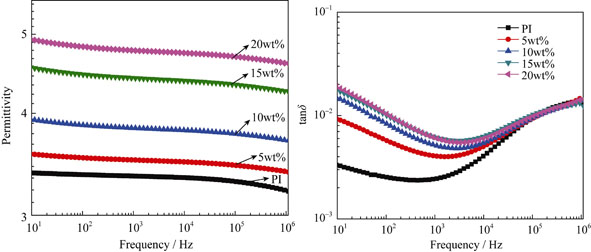
|
|
|
Growth of Low-dimensional ZnO Materials on Graphite Substrate
ZHANG Zhi-Kun, ZHANG Yu-Zhi, BIAN Ji-Ming, SUN Jing-Chang, QIN Fu-Wen, LIU Wei-Feng, LUO Ying-Min
2014 Vol. 29 (1): 103–107
 Abstract
Abstract(
1484 )
 HTML
HTML(
4)
 PDF
PDF(346KB)(
2220
)
Low-dimensional ZnO materials, (1-dimensional ZnO nanorods (NRs) and 2-dimensional ZnO films) were grown perpendicularly on graphite substrates. The crystalline structure, morphology, and optical properties of the as-grown low-dimensional ZnO materials were investigated with X-ray diffraction(XRD), field effect scanning electron microscope (FESEM), photoluminescence (PL), and the relative reflection spectra measurements. The high optical qualities of borth ZnO NRs and ZnO films on graphite substrates were demonstrated by the dominant near-band edge emission and nearly undetectable deep level emissions of photoluminescence spectra under room temperature. The extremely low average reflectance was obtained from the low-dimensional ZnO materials/graphite structures in the spectra range from 300 nm to 800 nm, indicating that the obtained low-dimensional ZnO materials/graphite structures have significant opportunity for potential application in high-performance photovoltaic devices.
|
|
|
Photoluminescence in Multifunctional Ferroelectrics: Pr-doped SrBi2Ta2O9
PENG Deng-Feng, ZOU Hua, LI Jun, CAO Qiu-Feng, HUI Xin-Wei, WANG Xu-Sheng
2014 Vol. 29 (1): 108–112
 Abstract
Abstract(
1073 )
 HTML
HTML(
2)
 PDF
PDF(306KB)(
1787
)
Pr-doped SrBi2Ta2O9 (SBTO) bismuth layered ferroelectrics are examined in this work. It is demonstrated that a certain amount of Pr-doped ceramic sample shows a strong red and green photoluminescence with blue excitation at room temperature. Photoluminescence excitation spectra show that the samples have broad blue excitation band. This blue band attributes to the f-f transitions from the 3H4 ground state to the 3PJ (J=0, 1, 2) excited states of Pr3+. Upon this blue excitation the samples show broad photoluminescence emissions, the emission peaks correspond to the characteristic f-f transition of Pr3+ at 3P1→ 3H5 (532 nm), 3P0→3H5 (546 nm), 1D2→3H4 (600 nm), 3P0→3H6 (620 nm), 3P0→3F2 (656 nm), and 3P0→3F4 (743 nm), respectively. The photoluminescence with a blue light excitation may make these Pr3+-doped SBTO phosphors suitable for white LED and related devices.
|
|